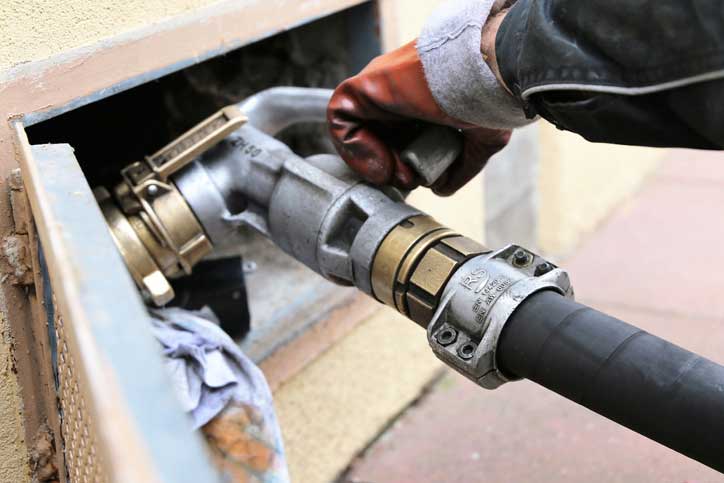- Home
- Loss Control
- Loss Control Insights
- Use This Practice to Avoid Fuel Delivery Disasters
Fall is nearly here, and the dropping temperatures mean that you’ll soon be getting more calls for fuel oil deliveries. There are a lot of factors involved in a smooth fuel delivery, but annual indoor tank inspections are a simple way to prevent problems and ensure a positive experience for your customers.
What Could Go Wrong?
While any kind of fuel delivery has the potential to hit a snag, fuel oil (often called home heating oil or No. 2 heating oil) has the potential to create a uniquely disastrous situation for both you and your customer. That’s because the storage tanks are generally located inside the home (usually in the basement) where they feed an oil-burning furnace or boiler.
Because of the proximity to living space, even a small indoor fuel spill can cause big problems for the inhabitants who might need to be evacuated from the home while it’s cleaned up. A more sizable spill—a hundred gallons or more—might require more drastic actions such as digging up entire basements for remediation, or even demolishing the whole house because it can’t be salvaged. Luckily, there’s an almost foolproof way to prevent large scale messes like these: an annual indoor tank inspection.
Tanks: Aging, Replacement and Removal
Your fuel delivery can only succeed if the receiving tank is in good enough condition to accept it.
You may not think of your customer locations as changing much, but the truth is that all equipment deteriorates a bit from year to year. A fuel tank and its corresponding connection and venting may have been in place for decades, with each passing year increasing the likelihood of leaks or damage.
Tanks may also be compromised when they’re incompetently repaired or replaced, either by a handy homeowner attempting to save some money or by a service technician who botched the installation.
Finally, the largest spills occur when there is no tank at all. This commonly happens when the homeowner has switched to propane for home heating and removed the unused fuel tank in the basement. It’s impossible for a delivery driver on the outside to know this has occurred, especially if the old oil lines haven’t been capped or cemented closed.
Want to make sure a customer’s tank is ready to perform? There’s only one way: see it with your own eyes before the delivery.
Inspect (and Document) Annually to Spot Trouble Before Delivery
Once a year, your service people should conduct a visual inspection of every indoor fuel tank. Assess the general condition of the tank and the area around it looking for possible issues such as ignition sources too close to the tank or broken shutoff valves.
We’ve got a handy inspection sheet PDF you can use to document your inspection—leave one copy for the customer and keep one copy in your customer file to serve as documentation. EMC policyholders can also order our inspection sheet as a carbon copy form to save your techs time in the field (you’ll need your policy number to order; find it on your insurance policy or contact your independent agent for help).
Tips for Scheduling Inspections
You’re busy and so are your customers, so it can be tricky to arrange a time to conduct your annual inspection. Here are some tips:
- Reach out to customers early—If possible, start contacting customers to set up inspection appointments before their tank starts running low. Additional lead time will make it easier to set up an appointment that’s convenient for the customer without the urgency created by a low fuel situation.
- Propose 2-3 appointment options—Customers may have an easier time scheduling an appointment if you call with a few proposed meeting dates/times in mind. Your suggested times may not work for every customer, but it gives you a starting point and may save you some back-and-forth communication.
- Consider online scheduling—An online scheduling service can reduce phone tag and makes it easier for customers to find available times that work for them. It can also help make sure you aren’t overbooked.
- Offer reminders—You can help prevent customer no-shows by reminding them of the upcoming appointment. A quick confirmation call, text or email is an easy way to help them remember. Many online scheduling services offer automated reminders.
- Plan ahead for cancellations—Despite your best efforts, customers will sometimes miss appointments. Whether they forgot about the meeting or something urgent came up, it’s important that you don’t let them fall through the cracks. If a customer doesn’t show up for an inspection appointment, do your best to reschedule as soon as possible and have a plan to follow up until the inspection is completed.
Other Ways to Prevent Delivery Problems
- Double-check all the details before filling to help avoid accidental delivery to the wrong address or delivering the wrong product.
- Follow the Fuel Delivery Checklist in our Accident Prevention Kit for Bulk Fuel/LP Dealers (we have a kit for convenience stores, too).
- Follow these fuel delivery best practices.
- Sign up for our free loss control newsletters.
Find More Online
Get in touch
Need help? We’re here for you! Whether you have questions or need personalized assistance, your local office is ready to support you.
Loss Control Insights
Stay informed with the latest news and receive actionable safety tips, all carefully curated by our team of experts.
